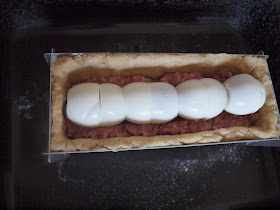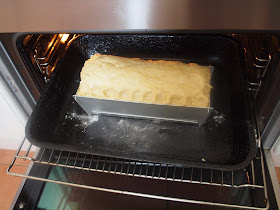
Build your mould together and grease and flour the inside.
Now hand raise some hot water pastry inside your mould, whilst remembering to save some for your lid.
Half fill your pastry mould with your seasoned pork mix and then using a tablespoon form a channel in the centre of the meat, this will allow your boiled eggs to sit centrally without rolling to one side.
Having done that, top and tail approximately seven hard boiled eggs until you can see the yolk.
Now butt up your eggs end to end and along the length of your pie mould, this will ensure when you slice your finished pie, you will see the yellow yolk all the way through the pie. (This is a trade secret and a good sign of a good and generous pie-maker)
Having placed your eggs in your mould, cover them with your seasoned pork.
Place on your pastry lid, crimp the edges, wash with egg and place in your oven at 180c degrees for 70 minutes. This next part is important, allow to cool for at least 40 minutes before removing the metal pie mould, this will stop the pie from bellying out.
You can if you wish and after first cooling your pie, egg wash the sides and finish off in a hot oven for a further 15 mins. Once totally cooled, you can fill the pie with gelatine and once set, slice and serve.








That looks great, Marc! The egg looks very attractive, but I'd probably actually prefer the Ascot Pie with cold egg slices on the side. I've never tried the hot water pastry. Must do that soon. And I've never seen a pan like that, one that comes apart.
ReplyDeleteHi Jean, I was just thinking about you and hot water pastry, asking myself, what vegetarian filling will she put inside? Maybe a Ratatouille? Here's a challenge for you Jean, a healthy Lardy Cake, think you could devise one?
ReplyDeleteIt's not often that I miss England but you've done it here, Marc. But two questions from someone who doesn't even know what hot water pastry is (I suppose that's a third question): (a) what do you mean by "hand raising" the pastry inside the tin? And (b) how do you get the gelatin in?! Is there some kind of culinary syringe I should be investing in?
ReplyDeleteHot water pastry is mixing the ingredients together whilst hot(best to work once cooled), the water and melted butter and lard. Hand raising is where you lob the pastry inside your tin and then with your fingers tease the pastry up the sides of the tin until you reach the rim (hence the nobbly look of the pastry inside the pie tin).Purchase from Vet's a large syringe (appx 5 euro's)to gelatine your pie. It is very important to gelatine your pie as it enters it dispels the air thus giving longevity to the shelflife.
ReplyDeleteThank you for explaining all that, Marc, I am loving learning all these things. Hand raising sounds like FUN. As does syringing a pie.
ReplyDeleteI've found that the egg can become a bit 'rubbery'. Any idea as to what causes this to happen, and how to prevent it?
ReplyDelete